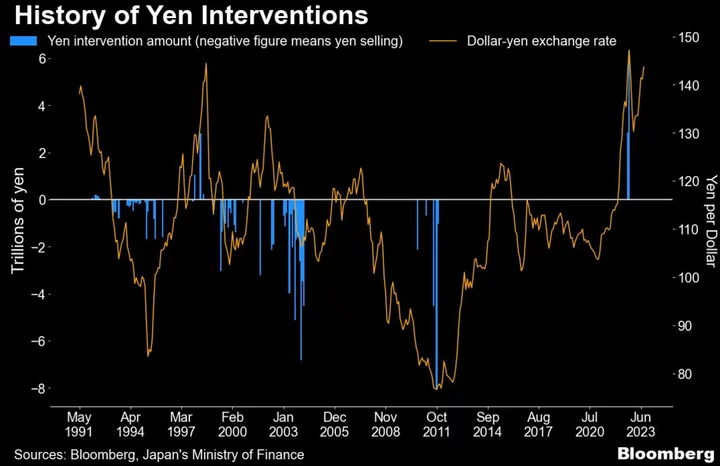Japan’s currency dropped toward a level that triggered the first yen-buying intervention since 1998 in September as yield differentials widened.
The yen held steady at 145.52 per dollar on Tuesday following six days of declines. On Sept. 22 last year, the Ministry of Finance bought ¥2.84 trillion ($19.5 billion) worth of yen when it weakened to 145.90.
The currency has depreciated about 3% since the Bank of Japan decided to tolerate higher benchmark bond yields on July 28, with Governor Kazuo Ueda saying that volatility in the foreign-exchange market was a factor for the decision. Yield differentials between Japan and other major economies have widened further since then, putting even more pressure on the yen to weaken despite the BOJ’s move.
“We believe the Ministry of Finance will start pushing back in the 145-148 range,” wrote Joey Chew, head of Asia FX research at HSBC Holdings Plc in a note. “If it does not, short positions on yen will likely be rebuilt further.”
Still, a decline in the yen to previous intervention levels may not immediately trigger action from the government. The Ministry of Finance is in charge of ordering currency-market intervention in Japan, which is then carried out by the BOJ.
“Japanese authorities are likely to worry about the speed of change more than the level of the yen when determining whether to intervene,” Carol Kong, an economist and currency strategist at Commonwealth Bank of Australia, wrote in a research note. “In our view, direct FX intervention is unlikely at this stage.”
For now, broad strength in the dollar may keep other major currencies on their back foot, including the yen. US real yields, measured based on inflation-protected 10-year notes, climbed to the highest since 2009 and were about 235 basis points more than their Japanese counterparts.
“It’s no surprise that market participants see dollar longs as the best choice,” Makoto Noji, chief currency and foreign bond strategist at SMBC Nikko Securities Inc., wrote in note. This is because “both US stocks and economy remain resilient despite high real yields.”
(Adds strategist comments.)

